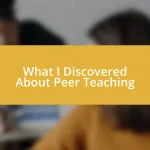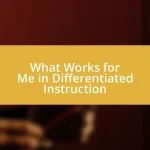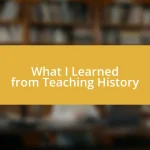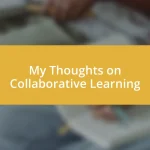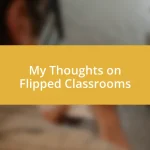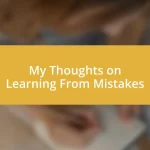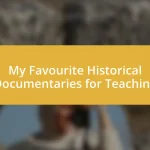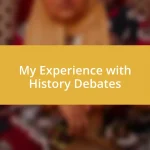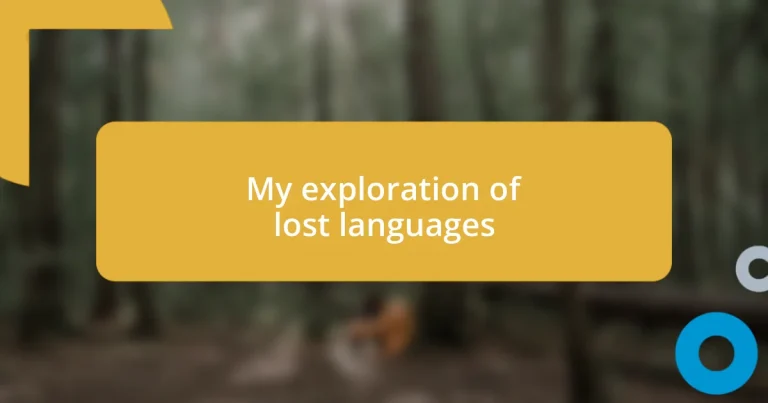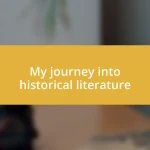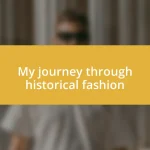Key takeaways:
- The Eyak language’s extinction illustrates the loss of traditional knowledge and cultural heritage, highlighting the importance of preserving languages for community identity.
- Exploring lost languages combines historical text analysis, linguistic anthropology, and technology, revealing insights into human communication and cultural practices.
- The revival of languages like Hawaiian and Cornish emphasizes the role of community initiatives and educational programs in revitalizing endangered languages for future generations.
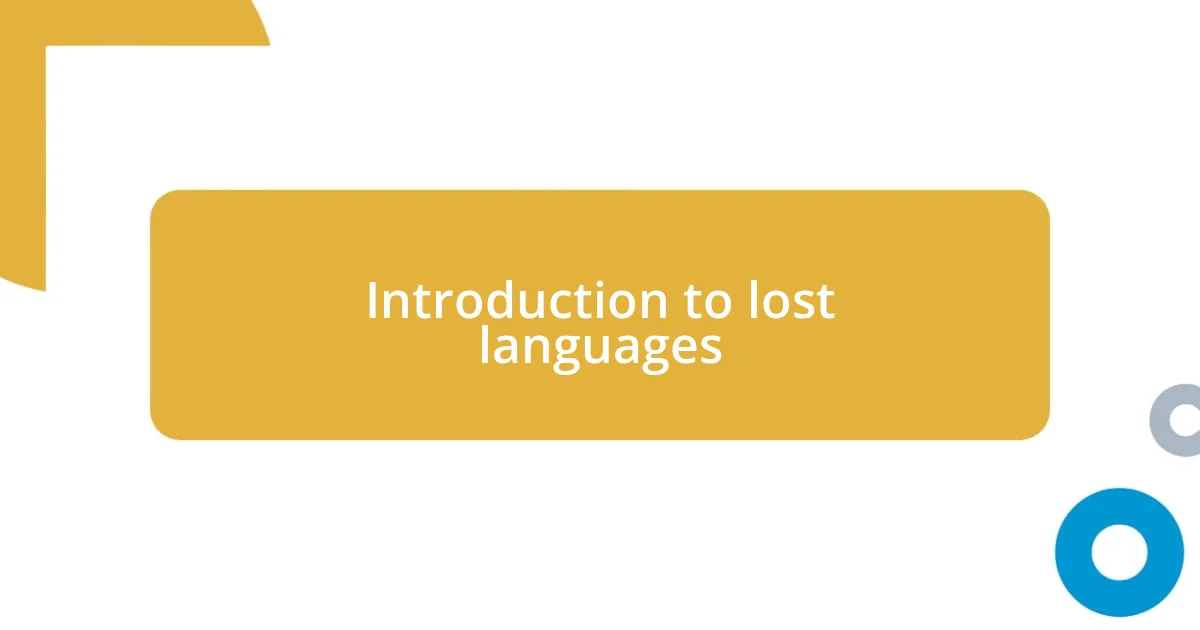
Introduction to lost languages
Lost languages hold a unique allure, don’t they? I often find myself fascinated by the idea of words and expressions that once conveyed the thoughts and feelings of entire communities, only to fade into silence. The mere thought that these languages once shaped identities and cultures invites a profound sense of melancholy and curiosity.
In my own journey through linguistics, I stumbled upon the story of the Eyak language, spoken in Alaska until its last fluent speaker passed away in 2008. It struck me deeply, realizing that in losing this language, we also lost a rich tapestry of traditional knowledge and cultural heritage. How many stories, customs, and unique perspectives have vanished along with those words? It’s a thought-provoking realization.
Exploring lost languages can feel like diving into time itself. For me, it opens up a window into human history and evolution. There’s something deeply human about wanting to understand and recover these voices from the past. It raises questions: What can we learn from them? And how can their absence make us appreciate our current languages even more? Each lost language is a reminder of the beauty and complexity of human expression, urging us to value the words we use today.
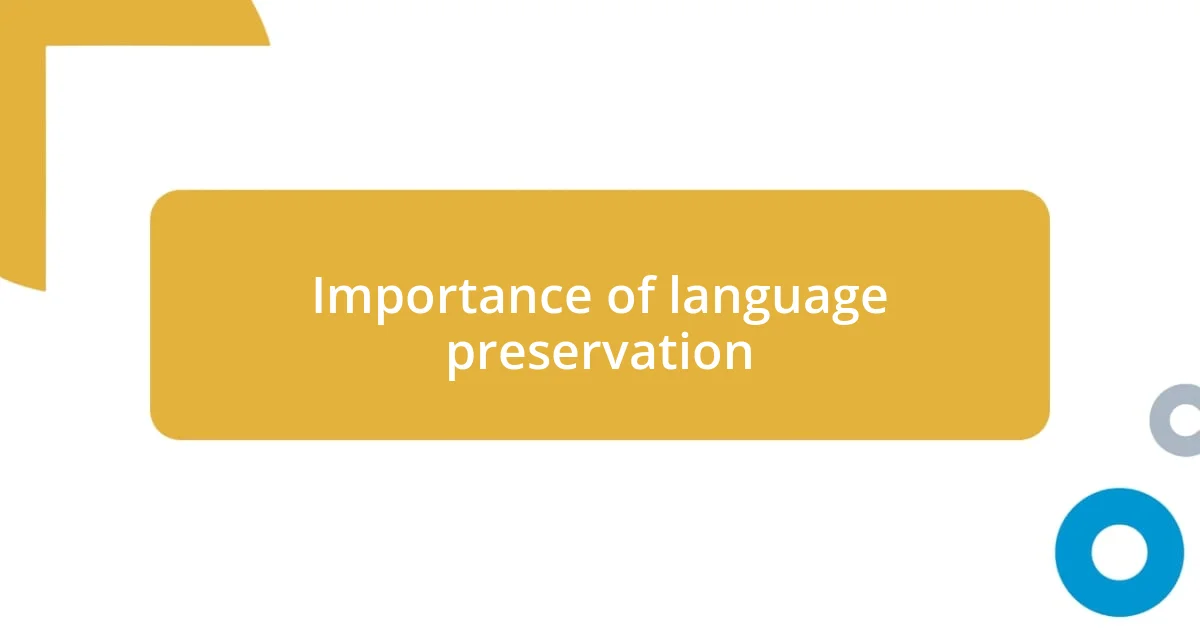
Importance of language preservation
The preservation of languages is crucial, not just for cultural heritage, but for the identity of communities. When I think back to my childhood, the stories my grandmother shared in her native tongue remind me of the cultural roots that shape who we are. Losing a language means losing that unique perspective and a whole world of knowledge; it’s like erasing a part of our collective memory.
Here are several key reasons why language preservation matters:
- Cultural Identity: Languages are vital for expressing cultural uniqueness and heritage.
- Knowledge and Traditions: Many languages carry traditional knowledge about local ecology, medicine, and history.
- Diversity: Each language adds to the richness of human experience, promoting diverse worldviews.
- Community Connection: Speaking a language fosters social bonds among community members, enhancing cohesion.
- Historical Insights: Lost languages can provide valuable insights into migration patterns and historical events.
In every lost language, there is a story of resilience and survival, urging us to pay attention to the silent voices echoing from the past.
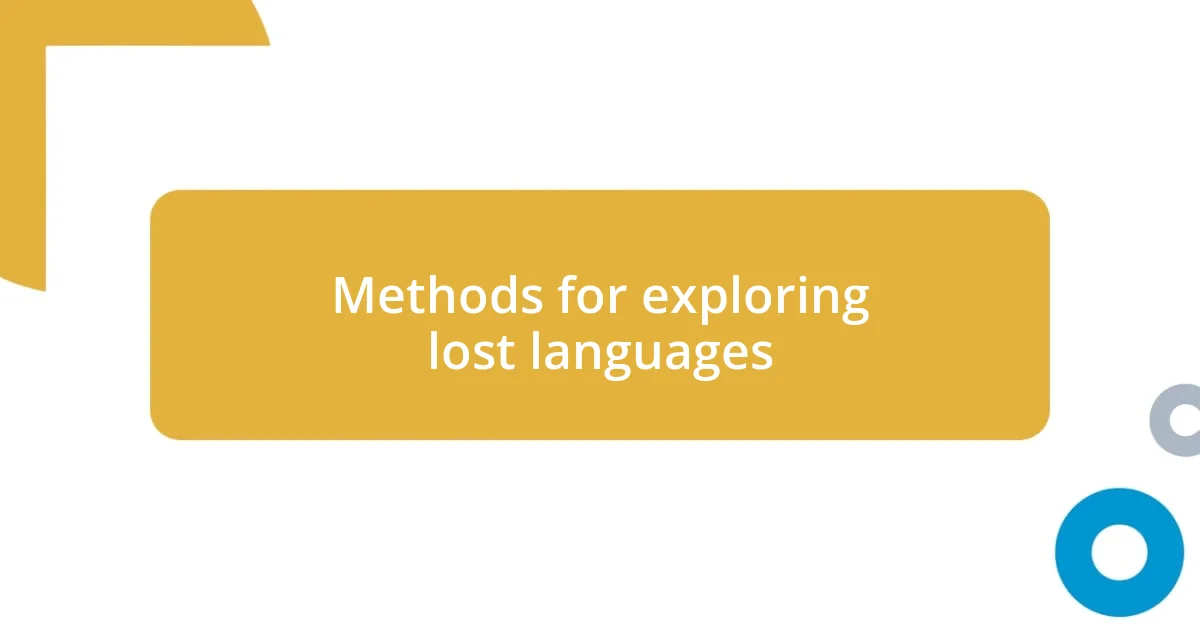
Methods for exploring lost languages
Exploring lost languages involves a multifaceted approach, and each method reveals unique insights into how people communicated and related to their world. I’ve found that studying historical texts and materials, like ancient manuscripts or inscriptions, often provides a direct glimpse into the linguistic structures and vocabulary of lost languages. This method, much like piecing together a forgotten puzzle, has taught me how languages evolve while retaining traces of their ancestors.
Another fascinating method I cherish is engaging with linguistic anthropology. By studying the cultural practices tied to language use, we can uncover methods of expression that go beyond mere words. For instance, I remember attending a workshop focused on the sound systems of extinct languages. Watching experts reconstruct phonetics brought alive the ghostly whispers of voices long silenced. It’s an emotional experience—one I’ll never forget.
Lastly, technological advancements have dramatically broadened our exploration of lost languages. The use of machine learning algorithms to analyze phonetic patterns or reconstruct grammar has intrigued me. I often ponder: how far can technology take us in this journey through time? The ability to simulate language work gives us hope to reclaim knowledge that may seem beyond our reach.
| Method | Description |
|---|---|
| Historical Text Analysis | Studying manuscripts and inscriptions to understand linguistic features. |
| Linguistic Anthropology | Examining cultural practices related to language to uncover deeper meanings. |
| Technological Reconstruction | Using machine learning to analyze and reconstruct lost linguistic patterns. |
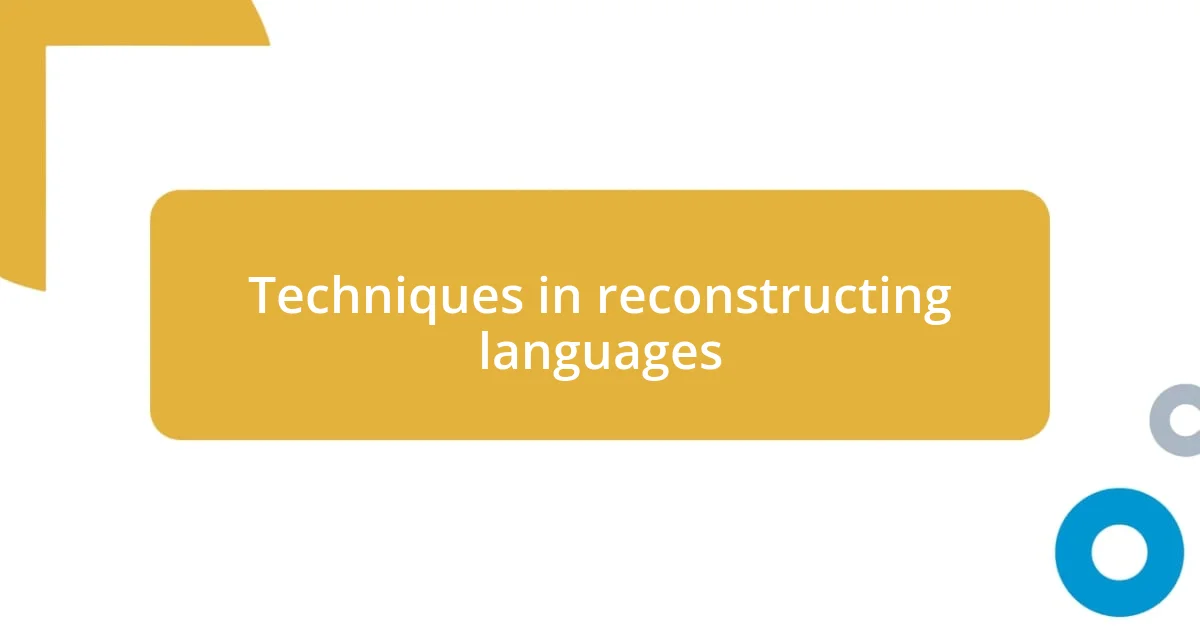
Techniques in reconstructing languages
Reconstructing lost languages is an intricate endeavor that combines various techniques, each revealing a layer of history and culture. I’ve delved into phonetic analysis, where slight variations in sound production can lead to significant insights about language families. For example, I remember listening to recordings of closely related languages and realizing how small shifts in tone could carry vast differences in meaning. It’s akin to sharpening the focus of an old photograph, bringing the details into clarity.
When working with comparative linguistics, I’ve noticed that examining similarities and differences between languages can illuminate their historical connections. While analyzing the patterns, I often ask myself—what stories do these similarities tell us? It’s fascinating to draw connections across continents, recognizing how languages, like rivers, can branch off from a common source, merging and diverging through time. These realizations captivate me; they highlight the unity and diversity of human expression.
Lastly, one technique that has profoundly affected my exploration is collaborative research with native speakers. I once participated in a project where fluent speakers of an endangered language shared their experiences, enriching our understanding of its nuances. Hearing their passion and pride left me in awe; I realized that every word they spoke carried weight, like threads weaving a tapestry of their identity. Engaging with speakers not only fills in linguistic gaps but also fosters a deep emotional connection to the language’s journey. Isn’t it incredible how language can bind us to our roots, even when the words become a whisper of the past?
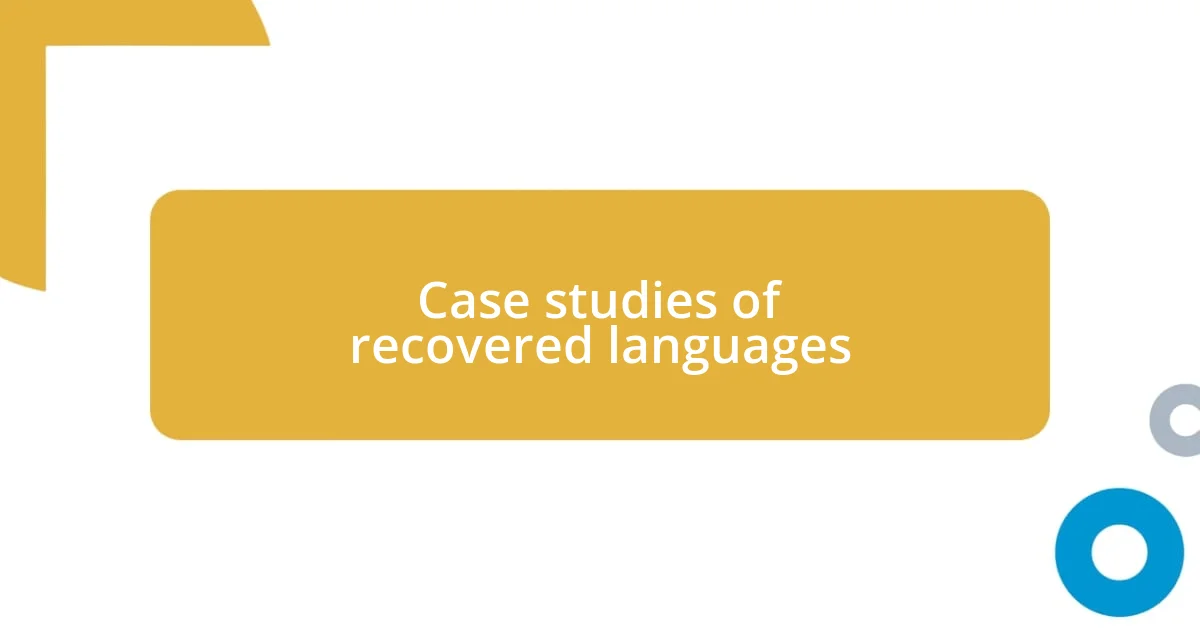
Case studies of recovered languages
One notable case study is that of the Rhaeto-Romance languages in the Italian Alps, which have experienced a revival after centuries of decline. I vividly recall listening to an interview with a linguist who dedicated years to documenting the dialects spoken in the region. Witnessing the community’s passion for reclaiming their lost tongue was inspiring; it felt like watching a phoenix rise from the ashes. Could language revitalization truly reshape cultural identity? For the locals, the answer was a resounding yes.
Another striking example is the Hawaiian language, nearly lost by the mid-20th century due to colonial influences. I remember attending a lecture where a speaker passionately shared how immersion schools sparked a significant turnaround, allowing a new generation to speak Hawaiian fluently. It made me reflect: what does it mean to bring a language back from the brink? The emotions in the room were palpable as attendees expressed their pride in re-establishing a connection to their heritage.
In the case of the Cornish language in England, the dedication of language activists led to its recognition as a minority language in 2002. I once visited a festival celebrating Cornish culture, where I met individuals who were fervently teaching the language to the younger population. Their commitment to passing down their linguistic heritage sparked a thought: how can one language embody a community’s spirit? Seeing people engage with Cornish made it clear—every word spoken is a testament to resilience and cultural continuity.
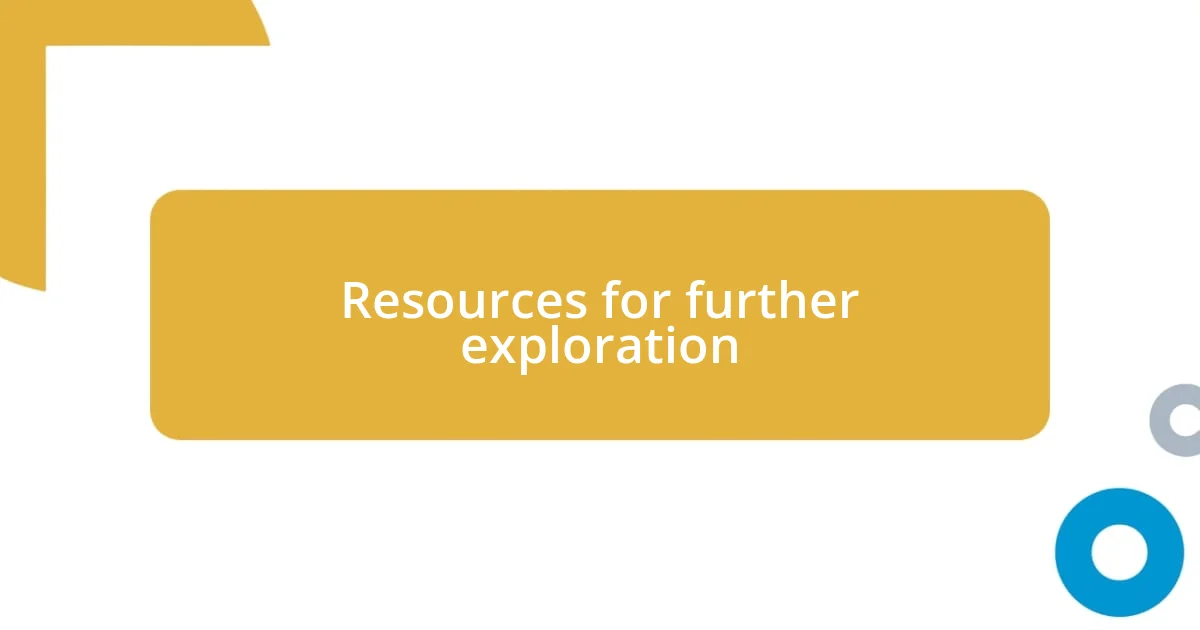
Resources for further exploration
When exploring lost languages, a wealth of resources is available to delve deeper. I often turn to platforms like the Endangered Languages Project, where researchers and enthusiasts share invaluable data on various languages at risk of disappearing. It’s thrilling to sift through recordings and documents, much like a treasure hunt; each finding feels like a piece of a larger puzzle waiting to be reassembled.
Books are another treasure trove for exploration. I’ve found that titles like “Lost Languages: The Getica and Its Significance” provide profound insights into ancient scripts and their connections to modern languages. There’s something captivating about the stories behind these texts—they breathe life into what could otherwise become mere footnotes in history. Have you ever read a book that transported you to another time and place? For me, those pages become a bridge to understanding the past.
Moreover, online courses and lectures can be game-changers. I once enrolled in a fascinating course on historical linguistics that opened my eyes to the evolution of languages over centuries. I can still remember the excitement of connecting linguistic dots that laid bare a language’s journey through time. How has your understanding of languages evolved with each new resource you encounter? The right learning opportunity can ignite a passion that spans generations, making the past resonate in the present.
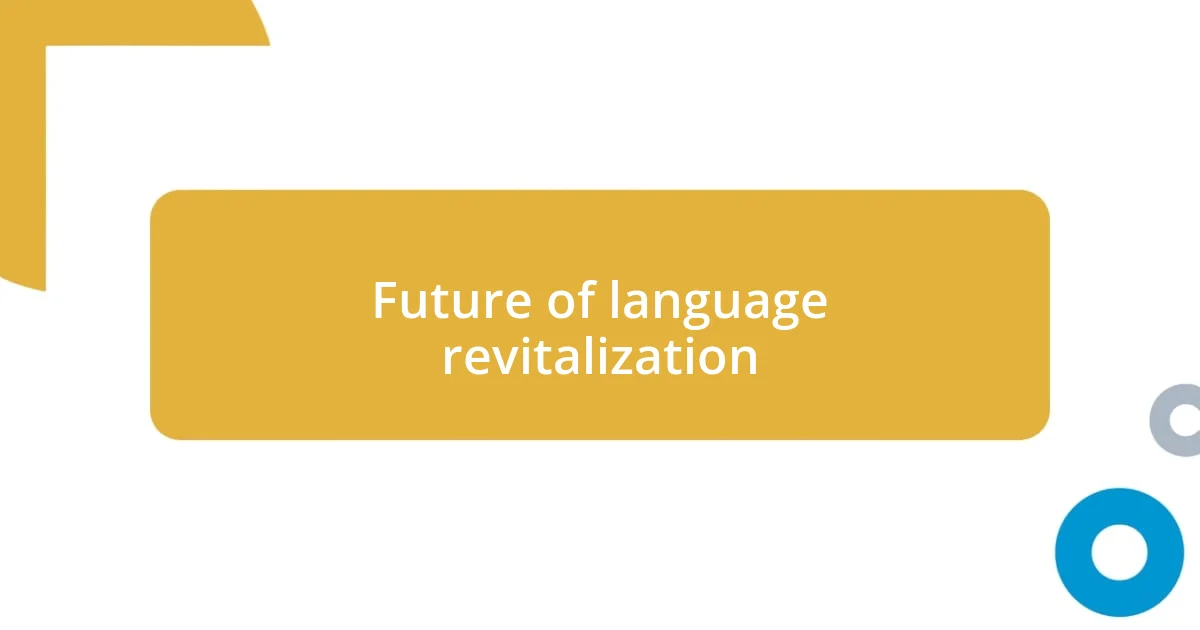
Future of language revitalization
As I think about the future of language revitalization, I see great promise in the power of technology. I’ve had experiences where online communities bring together individuals passionate about reclaiming their languages. During a virtual workshop, I felt an energy that was contagious as participants shared stories and resources, bridging distances that once seemed insurmountable. Could this digital landscape be the key to keeping endangered languages alive? I genuinely believe it could foster connections that amplify efforts to teach and learn lost languages.
Education is another pillar in this revitalization journey. I remember a time in college when I attended a bilingual education summit that sparked my interest in how curriculum development plays a crucial role. The idea that mainstream education can integrate endangered languages is thrilling; it feels like planting seeds for future generations to nurture. What if every child grew up with the chance to hear their ancestors’ language alongside their own? That vision left me hopeful and inspired to support educators who champion this cause.
Additionally, local communities play an essential role in sustaining these languages. I once volunteered in a cultural center where elders shared their indigenous tongue with eager learners, creating a vibrant exchange of knowledge. The joy on the faces of both the younger and older generations was infectious. Isn’t it remarkable how language can weave together generations? I truly believe that as local investments grow in language programs, we’ll witness an even more extensive resurgence, paving the way for languages once on the brink of extinction to flourish again.

